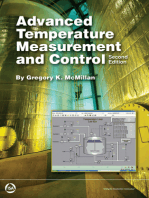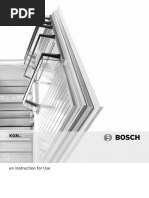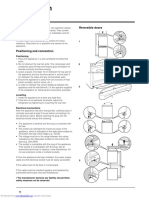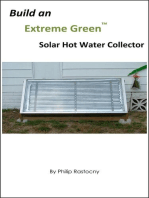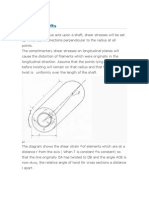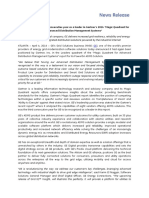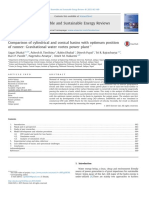English: Environmental Hints
English: Environmental Hints
Uploaded by
ufhCopyright:
Available Formats
English: Environmental Hints
English: Environmental Hints
Uploaded by
ufhOriginal Description:
Original Title
Copyright
Available Formats
Share this document
Did you find this document useful?
Is this content inappropriate?
Copyright:
Available Formats
English: Environmental Hints
English: Environmental Hints
Uploaded by
ufhCopyright:
Available Formats
N
English
ENVIRONMENTAL HINTS
Packing
Do not throw the packing into the garbage: first sort out the
different materials (i.e.: steel, cardboard, polystyrene) following local regulations.
Information
This appliance is free of CFCs (refrigerant circuit contains
R134a) or free of HFCs (refrigerant circuit contains R600a
Isobutane). For more details, please refer to the rating plate
on the appliance.
For appliances with Isobutane (R600a)
The refrigerant Isobutane is a natural gas of high environmental compatibility but which is inflammable. Therefore, it
is essential to ensure that the ducts of the refrigerant circuit
do not get damaged.
Declaration of conformity
This appliance is intended to come into contact with foodstuffs and conforms to D.L. 108 of 25.01.1992 (European Directive 89/109/EEC).
KNOW YOUR APPLIANCE
It is a combined refrigerator/freezer.
The freezer compartment, situated at the bottom, allows the
perfect storage of fresh and cooked foods, the production of
ice cubes and the storage of fresh and frozen foods.
The refrigerator compartment, which is provided with automatic defrost, allows the storage of fresh foods and beverages.
This appliance is provided with two motors: the refrigerator
and freezer compartments may be used separately.
Please read these instructions carefully.
They include a full description of your appliance and useful
hints to enable you to achieve the correct performances required to store foods.
If the appliance is provided with spacers, fit them at the top
of the condenser (Fig. 4).
The door support is for transport purposes only (Fig. 5).
Clean the inside of the liners with a sponge dampened in a
solution of lukewarm water and vinegar.
Fit the accessories as illustrated in Fig. 1 and Fig. 8.
ELECTRICAL CONNECTION AND
OPERATION
Please check that the voltage on the rating plate (Fig. 6),
which is situated at the right hand side of the crisper, corresponds to the voltage in your home (Fig. 7).
The earthing of this appliance is compulsory by law. The
manufacturer will accept no liability for injury to persons or damage to objects arising from the non-observance of this requirement.
Let the appliance to stand for one hour prior to connecting it
to the mains.
ELECTRICAL INFORMATION
WARNING - THIS APPLIANCE MUST BE EARTHED
(For Great Britain only)
Fuse replacement.
If the mains lead of this appliance is fitted with a BS 1363A
13 amp fused plug, to change a fuse in this type of plug use
an A.S.T.A. approved fuse to BS 1362 type and proceed as
follows:
DESCRIPTION OF THE APPLIANCE
a
b
c
e
f
g
h
i
l
(Fig. 1)
Refrigerator compartment
Light switch
Refrigerator compartment control button (thermostat)
Freezer compartment control button (thermostat)
Yellow luminous switch for fast freeze
Green luminous light for operation
Green pilot lamp for critical temperatures in the freezer
compartment
Grids (adjustable in height and in some models in inclination; some models may also be provided with a grid
with flap)
Glass separator (if provided)
Crispers
Refrigerator inner door liner with adjustable compartments (in some models a butter compartment is provided)
Freezer compartment with storage n and freezing-in m
baskets.
INSTALLATION
Please ensure that your appliance is undamaged.
Any transport damage must be reported to your dealer
within 24 h of receipt.
Do not install the appliance near to heat sources such as
cookers, central heating, boilers, sunlight, etc.
It must however be located in a well ventilated dry space.
Leave a 50 mm space betveen the top of the appliance and
any kitchen furniture (Fig. 2). The appliance should stand
level, this can be achieved by adjusting the front feet (Fig. 3).
1. Remove the fuse cover (A) and fuse (B).
2. Fit replacement 13A fuse into fuse cover.
3. Refit both into plug.
IMPORTANT: The fuse cover must be refitted when changing a fuse and if the fuse cover is lost the plug must not be
used until a correct replacement is fitted.
Correct replacement are identified by the colour insert or the
colour embossed in words on the base of the plug.
Replacement fuse covers are available from your local electrical store.
CONNECTION TO A REWIREABLE PLUG
If the fitted plug is not suitable for your socket outlet, then it
should be cut off and disposed of in order to avoid a possible shock hazard should it be inserted into a 13A socket elsewhere.
A suitable altenative plug should then be fitted to the cable.
The wires in this mains lead are coloured in accordance with
the following code;
BLUE - NEUTRAL (N)
BROWN - LIVE (L)
GREEN AND YELLOW - EARTH (E)
1. The GREEN AND YELLOW wire must be connected to the
terminal in the plug which is marked with the letter E or by
the Earth symbol or coloured green or green and yellow.
GB
2. The BLUE wire must be connected to the terminal which
is marked with the letter N or coloured black.
3. The BROWN wire must be connected to the terminal
which is marked with the letter L or coloured red.
GREEN AND
YELLOW (E)
BROWN (L)
CABLE CLAMP.
just the thermostat knob to position 3.
If you need colder temperatures in the compartment turn the
thermostat knob to the higher settings, position 4 - 5. Contrarily if the temperature in the compartment is too cold, turn
the knob to the lower settings, position 2 - 1.
We remind you that internal temperatures are affected by
the location of the appliance, the temperature of the surrounding air and the frequency of door opening.
The setting of the thermostat may have to be varied to allow
for these factors. The operation of the refrigerator compartment may be interrupted turning the thermostat knob to
symbol x.
ADJUSTING TEMPERATURES IN THE
FREEZER COMPARTMENT
BLUE (N)
Connection to a
typical 13 amp plug
For the Republic of Ireland only
The information given in respect of Great Britain will frequently apply, but a third type of plug and socket is also
used, the 2-pin, side earth type. In this case, the wire which
is coloured GREEN AND YELLOW must be connected to the
EARTH contact, and the other two wires to the two pins, irrespective of colour. The supply to the socket must be fitted
with a 16 amp fuse.
If the plug and the wall socket do not comply, have the socket replaced by a qualified electrician. He should also
check that the section of the socket wires can withstand the
power absorbed by the appliance. The use of adapters, multiple sockets and extension cords is not advisable.
If absolutely necessary, use simple or multiple adapters and
extension cords in compliance with local safety regulations
paying attention not to exceed the maximum amperage,
which is marked on the simple adaptors and on extension
cords and that of the total power marked on the multiple
adapters.
When the appliance is connected, the following devices
switch on:
Freezer compartment
- The green luminous switch , if it is in the on position.
- The red alarm/pilot lamp . It will remain alight until the
correct storage temperature has been reached (see chapter
Adjusting the temperature of the freezer compartment).
This pilot lamp switches on when:
a) the door of the freezer compartment has been left open
for a long time
b) the appliance has been loaded with fresh foods to be frozen
c) the interior temperature is not correct.
- The yellow luminous fast freeze switch , if this is in the on
position.
Refrigerator compartment
- The interior light, if the door is opened and the temperature
selector knob is not on position x (temporaneous interruption of operation).
After selection of the temperatures as indicated in the relevant chapters, three hours approx. are required in the freezer
compartment to reach the correct storage temperatures and
a short time is required in the refrigerator compartment to
reach the correct storage temperatures.
ADJUSTING TEMPERATURES IN THE
REFRIGERATOR COMPARTMENT
The temperature is controlled by the thermostat knob (Fig. 1
- ). At an ambient temperature included between +20oC
and +25oC, and a normal load of foods, we suggest you ad-
The temperature is adjusting with the thermostat knob (Fig.
1 ), situated on the control panel. In normal ambient conditions (ambient temperature included between +20oC and
+25oC), we suggest you turn the knob to position 3.
This position allows you to obtain the ideal -18oC storage
temperature for frozen foods for a long time, with the less
energy consumption. If the interior temperature is colder or
warmer than -18oC, adjust the thermostat control knob to
position 1 or to position 5 respectively. We remind you that
internal temperatures are affected by the location of the appliance, the temperature of the surrounding air and the frequency of door opening. The setting of the thermostat may
have to be varied to allow for these factors. The operation of
the freezer compartment may be interrupted by pressing
switch
(green light off).
USE OF THE REFRIGERATOR
COMPARTMENT (Fig. 8)
All items stored in the refrigerator compartment should be
wrapped in alluminium or plastic sheeting or kept in a covered container. This prevents food from becoming dry on the
surface and stops strong smells and flavours being transferred from one food to another. The coldest section of the refrigerator compartment is immediately above the crisper drawer. Different foods are best stored in the positions indicated hereafter.
Meats; sausages, fish, etc. These should be stored on the
shelf nearest the crisper.
Cooked foods, pies, jellies, etc; these should be stored on
the top grids.
Eggs, cheese and dairy produces; these should be stored
in the refrigerator compartment door.
Fruits and vegetables: store in the crisper drawer.
Canned food: once the can has been opened, transfer unused food into a non-metallic container.
Important: Do not place foodstuffs or containers against the
rear wall. Store foods so as to permit free circulation of air.
Do not line the shelves with paper or plastic.
Allow cooked food to cool before storing in the refrigerator
compartment.
DEFROSTING
Defrosting of the refrigerator compartment is completely automatic: the defrost water is conveyed into a tray on the
compressor casing situated at the rear of the appliance,
where it evaporates thanks to the heat produced during the
operation.
USE OF THE LOW TEMPERATURE
COMPARTMENT (Fig. 8)
symbol, it
In the freezer compartment, marked by the
is possible to freeze-in fresh or cooked foods, to produce ice
cubes and to store commercially frozen foods. The maximum storage volume is obtained removing the basket and
positioning the foods directly on the refrigerating grids.
GB
Due to the efficacity of the door seal, it is not always possible
to open the compartment door immediately after closing it:
wait some minutes and then try again.
FREEZINGIN
The maximum quantity, (in kg.) of foods which may be frozen in a 24 h period, at an ambient temperature of 25oC, is
indicated on the rating plate (Fig. 6).
The freezing-in compartment is situated at the top (Fig. 1
m ). If you need to freeze-in large quantities of foods we suggest you push the fast freeze button d (Fig. 1) (yellow pilot
lamp d on) 24 h prior to freezing-in and you leave it on for 24
hours after the introduction of foods.
Please do not modify the position of the thermostat knob.
Position the foods and remove the refrigerating grids. Do not
forget to switch off button d at completion of freezing-in. Do
not store warm foods in the freezer.
Do not re-freeze thawed or partially thawed foods. Refreeze
them after cooking. Wrap foods in aluminium foils or polythene bags or place them in the appropriate containers.
Label each pack indicating the freezing-in date and the contents. Further detailed information are given in the freezing
guide provided with the appliance. We remind you that the
freezer compartment maintains the correct storage temperature for 14/18 hours after a power failure.
Some models are provided with cold packs (eutectics).
Place them in the freezing-in compartment in strict contact
with the foods to lengthen the storage time up to 32/35
hours in case of a power failure. During this period, we suggest you leave the freezer compartment door closed.
PRODUCTION OF ICE CUBES
Fill the tray up to 3/4 of their height, then place them in the
freezing-in compartment.
Attention: Do not eat ice cubes or ice lollies immediately
after removal from the freezer compartment as they may
give rise to cold burns. Do not store glass containers with
liquids (fizzy drinks, water) in the freezer compartment. Only
use plastic containers.
STORAGE OF FROZEN FOODS
When buying deep frozen foods, make sure that wrapper or
packet is intact. If it bulges or sags or has spots of moisture
on it, it may not have been kept cold enough and the contents may have lost their original quality.
When home, store deep frozen foods in the low temperature
compartment with the least possible delay, as any appreciable rise in temperature may adulterate their freshness.
Store deep frozen foods no longer than the packet instructions recommend.
THAWING
Here are some basic suggestions:
Raw vegetables: do not thaw, put straight into boiling water
and cook as usual.
Meat (large cuts): thaw in the refrigerator compartment without unwrapping them. Before cooking, leave at room temperature for some hours, or defrost using your microwave.
Please follow the Manufacturers recommendations.
(small cuts): thaw at room temperature or cook directly.
Fish: thaw in the refrigerator compartment without unwrapping or cook directly before being completely thawed.
Previously cooked foods: re-heat in the oven without removing from its aluminium container.
Fruits: thaw in the refrigerator compartment.
DEFROSTING
Defrost the appliance once or twice a year, when the layer of
frost on the walls of the freezer compartment reaches a 3
mm thickness.
Proceed as follows:
- Disconnect the appliance from the mains (Fig. 9).
- Remove the ice trays.
- Wrap frozen foods in several layers of newspaper and
place them in the refrigerator compartment.
- Remove all the baskets.
- Remove the drain cap.
- Place a tray under the drain to collect the defrost water
(Fig. 10).
- Leave the compartment door open.
Do not use sharp or cutting instruments. Any damage
caused by the use of such instruments is not covered by
guarantee. At the completion of defrosting, dry carefully, reposition the cap and the baskets and reconnect the appliance to the mains. Set the thermostat knob to position 3
for 4 hours approx., then replace foods in the freezer and adjust the thermostat knob to its normal operating position.
Attention: A temperature rise of frozen foods during defrosting may shorten their storage life.
MAINTENANCE AND CLEANING
A periodic and proper maintenance will ensure a longer life
to your appliance. When carrying out cleaning operations
or maintenance, always disconnect the appliance from
the mains supply. Periodically clean the inside of the refrigerator and freezer compartments with a sponge dampened in a solution of lukewarm water and vinegar. Rinse and
dry carefully.
Never use detergents or abrasives. Some appliances are fitted with a drain filter. To allow a paper water-flow, clean periodically the filter placed under the drain hose using the
plastic tool provided with the appliance (Fig. 11). Clean the
outside of the appliance with a sponge dampened in warm
water. Dry carefully with a soft cloth. Periodically clean the
condenser (Fig. 12) with a vacuum-cleaner.
HINTS FOR HOLIDAYS
If you plan to be away for a long time: disconnect the appliance from the mains supply, empty and clean the inside
of the two compartments. Leave the doors open to prevent
the appliance from smelling musty.
If you plan to be away for a short time: let the appliance
operate normally.
ENERGY SAVING HINTS
You can save energy to operate your appliance.
- Check the door gaskets.
- Ensure that the appliance is level to facilitate door closing.
- Periodically clean the
compartment of your appliance. Defrost it when the frost reaches a 3 mm thickness.
- Periodically clean the condenser.
- Open the doors only when necessary; close them immediately after removing foods.
- Do not set the thermostat knob to extremely cold positions;
you waste energy.
- Ensure that the appliance is not installed near a heat
source such as cookers, radiators, water heater or to direct
sunlight.
SERVICE
The incorrect operation of the appliance is not always due to
a fault but it may also result from poor installation or usage.
To prevent unnecessary service calls for which you will be
charged, we suggest you consult this trouble-shooting
guide.
1. The temperature in the compartments is not cold
enough. Check that:
- the doors are properly shut
- the thermostats are in the correct position
- the appliance is not too close to a heat source
7
GB
- the condenser (black grill) is clean (Fig. 12)
- the air flow is not restricted.
2. The temperature in the refrigerator compartment is
too cold.
Check that:
- the thermostat control knob is in the correct position.
3. The appliance is excessively noisy. Check that:
- the appliance is not in contact with adjacent fitments which
may cause noise due to vibration.
- the refrigeration system pipe-works at the rear of the cabinet are not vibrating or the pipes do not touch each other.
4. The appliance does not work at all and the interior
light is off.
Check that:
- the supply plug is making good contact with the supply socket.
- there is not a power failure.
- the thermostat control knob is on position x.
- check the plug fuse by connecting another appliance to
the supply socket.
- the supply cable is broken.
5. Water on the floor of the refrigerator compartment.
Check that:
- the thermostat correctly set;
- the defrost water drainage system is not blocked;
- the filter in the drain hole is not obstructed (see chapter
Maintenance) (Fig. 13).
6. The interior light does not work
See point 4. Unplug the appliance and remove the lamp
cover.
Check that the bulb is not loose - tighten it if necessary.
To change the faulty bulb, proceed as above and fit a replacement bulb of not more than 15 W rating (Fig. 15).
7. The door seal is warm (Fig. 14).
It is not a fault - it prevents the formation of condensation.
Note: When replacing a damaged supply cord, be sure the
new cord is correctly clamped.
If you have followed the above checks and your appliance
still does not work properly, get in touch with the Service Division. Addresses and telephone numbers can be found on
the Service Registration Card.
State clearly what is wrong and the type and serial number
of your appliance. These data are on the rating plate (Fig. 6).
You might also like
- Hatz 1B Workshop ManualDocument212 pagesHatz 1B Workshop ManualMiroslav Jebavý82% (28)
- Advanced Temperature Measurement and Control, Second EditionFrom EverandAdvanced Temperature Measurement and Control, Second EditionNo ratings yet
- Gorenje K 337 2 MelaDocument18 pagesGorenje K 337 2 Meladjdr1No ratings yet
- LG GR-389SQF User Manual (17 Pages)Document17 pagesLG GR-389SQF User Manual (17 Pages)piero59100% (1)
- Operating Instructions: FreezerDocument5 pagesOperating Instructions: FreezerLacus Bognar100% (1)
- Datos Técnicos RefrigeradorDocument25 pagesDatos Técnicos RefrigeradorMiguel Mancilla100% (2)
- Operating Instructions: Refrigerator/Freezer CombinationDocument12 pagesOperating Instructions: Refrigerator/Freezer CombinationdexNo ratings yet
- Operating Instructions Indesit BAN 12 NF SDocument12 pagesOperating Instructions Indesit BAN 12 NF Scinefil70No ratings yet
- Electrolux RM 212 Caravan FridgeDocument5 pagesElectrolux RM 212 Caravan FridgeAdam Daines100% (1)
- Isotherm Cruise ManualDocument10 pagesIsotherm Cruise ManualPawel Vlad LatoNo ratings yet
- Fridge/freezer Combined: Installation and UseDocument20 pagesFridge/freezer Combined: Installation and UseKlara HadžiefendićNo ratings yet
- Balay 3FE2430B EsDocument71 pagesBalay 3FE2430B EseagleeyezNo ratings yet
- Manual Utilizare FrigiderDocument20 pagesManual Utilizare FrigiderSabinaNo ratings yet
- Haier Bd 106a Users Manual 259766Document68 pagesHaier Bd 106a Users Manual 259766bourefisNo ratings yet
- User ManualDocument5 pagesUser ManualrafeeqcscsNo ratings yet
- BD 146gaaDocument68 pagesBD 146gaalbust002No ratings yet
- Frigorifero 75 LitriDocument29 pagesFrigorifero 75 Litrialessio.bascNo ratings yet
- Man CruiseDocument73 pagesMan CruiseDaniel MocanuNo ratings yet
- Goodman Outdoor T-Stat I&O Manual March06Document8 pagesGoodman Outdoor T-Stat I&O Manual March06dominicanomd4018No ratings yet
- Electrical Connection (U.K. Only) : ImportantDocument33 pagesElectrical Connection (U.K. Only) : ImportantJeremy ColmenarezNo ratings yet
- Ariston Upright Freezer No Frost Up 350 Fi Fe Users Manual 418664Document17 pagesAriston Upright Freezer No Frost Up 350 Fi Fe Users Manual 418664Maximiliano BértoloNo ratings yet
- White Rodgers ThermostatDocument8 pagesWhite Rodgers ThermostatRosa OsbornNo ratings yet
- Hotpoint Ffa45wDocument20 pagesHotpoint Ffa45wdonioiNo ratings yet
- BDF-86V158 110V60HzDocument18 pagesBDF-86V158 110V60HzMAC SUCESORESNo ratings yet
- Bosch RefrigeretorDocument26 pagesBosch RefrigeretorMos CraciunNo ratings yet
- Fridgidair Freezer Model LFUH21F7LM2Document11 pagesFridgidair Freezer Model LFUH21F7LM2resisterNo ratings yet
- Electric Mini Tank Water Heaters GL 2.5 - GL 4 - GL 6+: Mts Makes Use of Recycled PaperDocument13 pagesElectric Mini Tank Water Heaters GL 2.5 - GL 4 - GL 6+: Mts Makes Use of Recycled PaperService Pemanas AirNo ratings yet
- Fridge Zanussi ZK2411VT5 ManualDocument14 pagesFridge Zanussi ZK2411VT5 ManualDragos MoscuNo ratings yet
- MFL60345903 (Eng) - ViperDocument12 pagesMFL60345903 (Eng) - ViperMuhammad Tanvirul IslamNo ratings yet
- Indesit BAN 34 NF PDocument10 pagesIndesit BAN 34 NF PДушко Ћосић0% (1)
- Emerson Fridge ManualDocument12 pagesEmerson Fridge Manualburndtjamb2000No ratings yet
- Fridge-Freezer Combined: Instructions For Installation and UseDocument16 pagesFridge-Freezer Combined: Instructions For Installation and UseJoe DoeNo ratings yet
- Kenmore Refridgerator ManualDocument80 pagesKenmore Refridgerator ManualMacGuyBeta100% (1)
- BDF-40H300220V50HZ KeldDocument19 pagesBDF-40H300220V50HZ KeldMAC SUCESORESNo ratings yet
- GY-NE250RF Instruction ManualDocument15 pagesGY-NE250RF Instruction ManualpinaNo ratings yet
- USA Lab HXC-L420 Blood Bank Refrigerator ManualDocument14 pagesUSA Lab HXC-L420 Blood Bank Refrigerator ManualKarol AndradeNo ratings yet
- Deshielo Tarjetas MabeDocument22 pagesDeshielo Tarjetas Mabevictor5everardo5ramiNo ratings yet
- MFL56987001 - Viper (English) LGDocument12 pagesMFL56987001 - Viper (English) LGharveymethinksNo ratings yet
- Rm4211 ManualDocument10 pagesRm4211 ManualpapanadaNo ratings yet
- Salus Controls Programmable Room Thermostat With RF (Volt Free) Model 091FLRFDocument28 pagesSalus Controls Programmable Room Thermostat With RF (Volt Free) Model 091FLRFMihailo Vuk MarinkovićNo ratings yet
- Samsung SR 608ev, Sr648ev, Sr688evDocument64 pagesSamsung SR 608ev, Sr648ev, Sr688evDavid LinaresNo ratings yet
- M FL 30138153Document80 pagesM FL 30138153amit1234No ratings yet
- Nf245nivr 2012-02-22Document32 pagesNf245nivr 2012-02-22StrahinjaNo ratings yet
- Craig's Thermostat CircuitsDocument10 pagesCraig's Thermostat CircuitsPramodh KjNo ratings yet
- Iceco JP304050Document24 pagesIceco JP304050sapeNo ratings yet
- Indesit IBD 5517Document12 pagesIndesit IBD 5517gefexej913No ratings yet
- GC l207wvqDocument80 pagesGC l207wvqcaracas293345100% (1)
- Freezer: Instructions For Installation and UseDocument12 pagesFreezer: Instructions For Installation and UseromancyyNo ratings yet
- Whirlpool SBS 2006 Collection Repair ManualDocument13 pagesWhirlpool SBS 2006 Collection Repair ManualNeil Pound100% (1)
- Thermostat 9825i2Document1 pageThermostat 9825i2mazda8616No ratings yet
- Index: Single Split English 11/2002Document20 pagesIndex: Single Split English 11/2002sajid_xeroxNo ratings yet
- Manual de Instrucciones ELECTROLUX EJF3642AOXDocument68 pagesManual de Instrucciones ELECTROLUX EJF3642AOXDarkuria D. DovahChildNo ratings yet
- Idael-Isar Boiler ManualDocument13 pagesIdael-Isar Boiler Manualsachin_sawant1985No ratings yet
- Thermostat Carrier Install ManualDocument12 pagesThermostat Carrier Install ManualSimNo ratings yet
- Installation and Operation Instructions For Custom Mark III CP Series Oil Fired UnitFrom EverandInstallation and Operation Instructions For Custom Mark III CP Series Oil Fired UnitNo ratings yet
- Family Handyman Whole House Storage & OrganizingFrom EverandFamily Handyman Whole House Storage & OrganizingFamily HandymanNo ratings yet
- Digital LED Thermometer with Microcontroller AVR ATtiny13From EverandDigital LED Thermometer with Microcontroller AVR ATtiny13Rating: 5 out of 5 stars5/5 (1)
- ShaftDocument8 pagesShaftshaafiqueNo ratings yet
- SVERKER650Document4 pagesSVERKER650Nagesh RaoNo ratings yet
- A Seminar On Determining The Value of Horizontal Magnetic Field of Earth by MagnetometersDocument39 pagesA Seminar On Determining The Value of Horizontal Magnetic Field of Earth by MagnetometersKamaljit RajkumarNo ratings yet
- Safe Diagram - A Design and Reliability Tool For Turbine BladingDocument26 pagesSafe Diagram - A Design and Reliability Tool For Turbine Bladingagnivesh22No ratings yet
- Xylem AC-13D Home DefenderDocument2 pagesXylem AC-13D Home DefenderfredguyNo ratings yet
- Adms GartnerDocument3 pagesAdms GartnerMuhammad RazeenNo ratings yet
- B17 IR SpectrometryDocument3 pagesB17 IR SpectrometryBalasubramanian AnanthNo ratings yet
- Comparison of Cylindrical and Conical Basins With Optimum PositionDocument8 pagesComparison of Cylindrical and Conical Basins With Optimum PositionArif HariyadiNo ratings yet
- Control RelaysDocument32 pagesControl RelaysAhmed Boussoffara100% (1)
- Condition Assessment Manual: Appendix 1.13 - Guide For Raw Water System Condition AssessmentDocument16 pagesCondition Assessment Manual: Appendix 1.13 - Guide For Raw Water System Condition AssessmentnourooziNo ratings yet
- Assp+z359 0-2023Document40 pagesAssp+z359 0-2023Marlon PerezNo ratings yet
- Thermal Management of Machine Compartment in A Built-In RefrigeratorDocument7 pagesThermal Management of Machine Compartment in A Built-In RefrigeratorMilind DevleNo ratings yet
- White6ed P6.52 53Document2 pagesWhite6ed P6.52 53Prince John MedinaNo ratings yet
- BASF - APE System PDFDocument86 pagesBASF - APE System PDFrendroedywibowoNo ratings yet
- 17a02apm - APM800 MX Add Power Supply Monitor ModDocument3 pages17a02apm - APM800 MX Add Power Supply Monitor ModInférus AdvenæNo ratings yet
- Chapter 3: Momentum and ImpulseDocument3 pagesChapter 3: Momentum and ImpulsePriyaa JayasankarNo ratings yet
- Braking ResistorDocument14 pagesBraking ResistorMPCReaderNo ratings yet
- Five Forces Model TESLADocument11 pagesFive Forces Model TESLANeha SoniNo ratings yet
- Bill of Supply For Electricity Due Date: 12-09-2022: BSES Rajdhani Power LTDDocument1 pageBill of Supply For Electricity Due Date: 12-09-2022: BSES Rajdhani Power LTDNand Kishor100% (1)
- Book Manual 103 BapatlaDocument80 pagesBook Manual 103 BapatlaAjay ReddyNo ratings yet
- Human Values and Professional Ethics (Backlog) Hmts 2001Document2 pagesHuman Values and Professional Ethics (Backlog) Hmts 2001Vikash KumarNo ratings yet
- Açık Uçlu Termodinamik SorularıDocument14 pagesAçık Uçlu Termodinamik Sorularıteknoloji.minemelisNo ratings yet
- Key Macro-Economic Challenges For India, at Present, Include: InflationDocument5 pagesKey Macro-Economic Challenges For India, at Present, Include: InflationAmita SinwarNo ratings yet
- Exp10 Villacampa Mary MayDocument9 pagesExp10 Villacampa Mary MayJay-ar BensOnNo ratings yet
- PNOZ X2 8P enDocument9 pagesPNOZ X2 8P enHamed MokhtariNo ratings yet
- Biology Unit 3 Metabolism Study GuideDocument8 pagesBiology Unit 3 Metabolism Study GuideezbalataNo ratings yet
- Separation of MV and LV Earthing Systems in Electrical Distribution Substations - 2 ColumnDocument3 pagesSeparation of MV and LV Earthing Systems in Electrical Distribution Substations - 2 ColumnsanibubaNo ratings yet
- Business Plan 50 MW MR - HilmyDocument5 pagesBusiness Plan 50 MW MR - HilmykdccjsilvaNo ratings yet
- Hydroprocessing Reactor Internals (UOP Unity) Tech SheetDocument2 pagesHydroprocessing Reactor Internals (UOP Unity) Tech Sheetsyeldan kemalettinNo ratings yet

